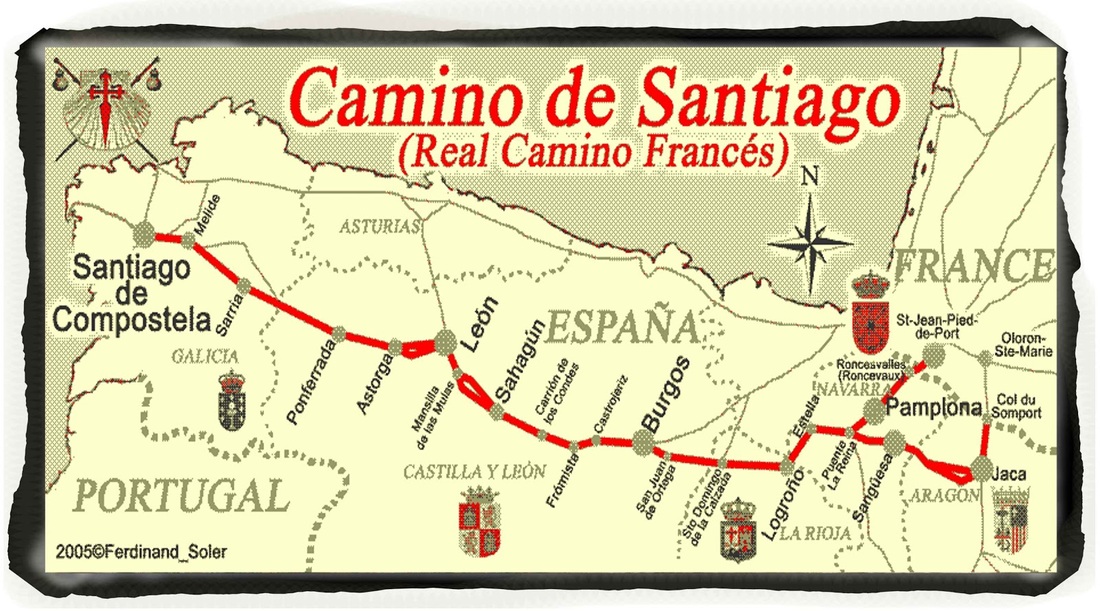

You next trek into a vast valley and garden paradise of fruit orchards, vegetable gardens, and unique El Bierzo wines. After summiting Monte Irago, the Camino’s highest point, pilgrims can leave a ritual stone at the foot of the Cruz de Ferro (iron cross)-for many, one of the most meaningful experiences on the journey. Slowly leaving the open meseta, the Camino passes into the multicolored mountains of León, so rich with minerals that ancient peoples, including Romans, built extensive roads here.

Mountainous terrain makes this one of the more challenging sections of the Camino. To Participate in the Iron Cross Ritual (and For a Challenge!): León and Galicia: León to Sarría Burgos, at the beginning of this route, is home to a world-class human evolution museum and also the gateway city to the Atapuerca archeological site, inhabited by humans 1.2 million years ago. At an albergue (hostel) in Carrión de los Condes, singing nuns invite you to listen to or join in sacred song. The food reflects this sturdiness with hearty farmer fare and strong wine. It is characterized by endless sky and wide horizons, which brings a different cadence to the walk. Land of hefty hilltop castles and frontier towns, this is El Cid country, saturated with epic poems of chivalrous (and roguish) knights. For Ancient Architecture and Medieval Lore: Castile and León: Burgos to Leónĭeep into Spain’s breadbasket, the Camino gradually climbs and enters the famous meseta-high plateau-of north-central Spain, with infinite swaying wheat fields where shepherds have tended their flocks for millennia. Here, you enter into remote pine forests rich with song birds and pass some of the path’s most spiritual monasteries, at Nájera, San Millan de la Cogolla, and San Juan de la Ortega. For Peaceful Monasteries and Plentiful Poppies: La Rioja and Castile: Logroño to Burgosĭefined by radiating vineyards and billowing wheat fields awash with red poppies in spring, the Camino treads along dark, rust-red earth that, toward Castile, turns gold. Filling your scallop shell with local red wine at Bodegas Irache Wine Fountain is a relatively new Camino tradition that has quickly become a classic.

The Camino also traverses an ancient Roman road and takes you into wheat and wine country, including a surprise at the monastery of Irache: a fountain flowing with wine. For Stunning Churches (and a Wine Fountain!): Navarra: Pamplona to Logroñoīeginning in Pamplona, Hemingway’s famed stomping ground, the Camino climbs and descends between open plains, high ridges, and steep ravines into wild and dynamic landscapes where early humans built dolmens and medieval masons created enigmatic and beautiful churches reflecting a mix of influences (pagan, Jewish, Christian, and Muslim), including Eunate, Torres del Rio, Cirauqui, Puente la Reina, and Estella. Especially from fall through spring, the weather can be prohibitive. This initial stretch is one of the most challenging on the Camino and includes the second-highest peak of the entire way. Throughout you are immersed in ancient Basque and Navarran culture, its hospitality, and its celebrated, colorful cuisine. Both ascend green-gray mountain peaks capped with snow and speckled with grazing sheep, leading to breathtaking views before descending to the huddled monastic hamlet of Roncesvalles. You have two traditional options here: the popular Route Napoleon or the Route Valcarlos, which is used in winter and bad weather. The Camino de Santiago today officially begins at Saint-Jean-Pied-de-Port, a stunning threshold at the Pyrenees and the border with France and Spain.

For Mountains and Huddled Hamlets: Basque Country and Navarra: Saint-Jean-Pied-de-Port to Pamplona Whatever your goals, plan your pilgrimage with this breakdown of Camino routes: The view from Rue de la Citadelle in Saint-Jean-Pied-de-Port, where the Camino officially begins. Even a three-day walk on the Camino is profound and transformative, and there are no right or wrong ways to walk it. While plenty of people walk the whole thing, many often walk the trail in sections, returning a year or more later to pick up where they left off.
#El camino de santiago route plus#
It can take anywhere from 31 to 45 days to walk the entire Camino de Santiago, from the French border at the Pyrenees to Santiago de Compostela, plus up to 7 days more to continue onward to the Atlantic coast.


 0 kommentar(er)
0 kommentar(er)
